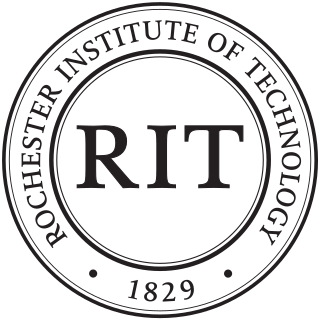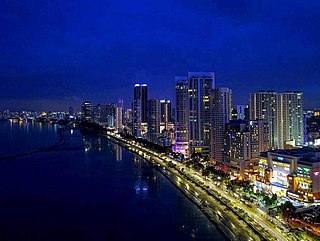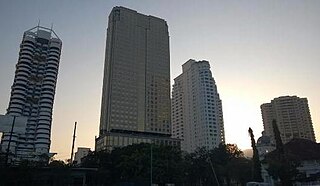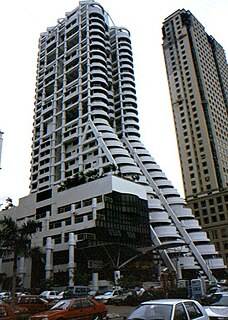
Penang is a Malaysian state located on the northwest coast of Peninsular Malaysia, by the Malacca Strait. It has two parts: Penang Island, where the capital city, George Town, is located, and Seberang Perai on the Malay Peninsula. They are connected by Malaysia's two longest road bridges, the Penang Bridge and the Sultan Abdul Halim Muadzam Shah Bridge; the latter is also the second longest oversea bridge in Southeast Asia. The second smallest Malaysian state by land mass, Penang is bordered by Kedah to the north and the east, and Perak to the south.

Rochester Institute of Technology (RIT) is a private research university in the town of Henrietta in the Rochester, New York, metropolitan area. The university offers undergraduate and graduate degrees, including doctoral and professional degrees and online masters as well.

George Town is the capital city of the Malaysian state of Penang. George Town is Malaysia's sixth most populous city with 708,127 inhabitants as of 2010, while Greater Penang, with a population of 2,412,616, is the second largest conurbation in the country after Greater Kuala Lumpur. The historical core of George Town has been inscribed as a UNESCO World Heritage Site since 2008.

The National Technical Institute for the Deaf (NTID) is the first and largest technological college in the world for students who are deaf or hard of hearing. As one of nine colleges within the Rochester Institute of Technology (RIT) in Rochester, New York, NTID provides academic programs, access, ASL in-class interpreters and support services—including on-site audiological, speech-language, and cochlear implant support. As of fall quarter 2012, NTID encompasses just under 10% of RIT's enrollment, 1259 students. Roughly 775 deaf and hard of hearing students are cross-registered into another RIT college's program with support from NTID.

The Tun Abdul Razak Complex, ; colloquially known by its Malay acronym Komtar, formerly known as the Penang New Urban Center and the Central Area Redevelopment Plan for Penang, is a multicomplex located in the city of George Town, Penang, Malaysia. The complex comprises retail outlets, a transportation hub, and a skyscraper, containing the administrative offices of the Penang state government. It was named after Abdul Razak Hussein, the second Prime Minister of Malaysia, who officiated the construction of the complex.

Seberang Perai is a city in the Malaysian state of Penang. It is situated on the Malay Peninsula opposite Penang Island, bordering Kedah to the north and east and Perak to the south. Its city centre is located in Butterworth, while its local authority, the Seberang Perai City Council, is centred near Bukit Mertajam. As of 2010, Seberang Perai had a population of 815,767, making it the second most populous city in Malaysia.

The architecture of Penang reflects the 171 years of British presence on the island, coalescing with local, Chinese, Indian, Islamic and other elements to create a unique and distinctive brand of architecture. Along with Malacca, Penang is an architectural gem of Malaysia and Southeast Asia. Unlike Singapore, also a Straits Settlement, where many heritage buildings had to make way for modern skyscrapers and high-rise apartments due to rapid development and acute land scarcity, Penang's architectural heritage has enjoyed a better fate. Penang has one of the largest collections of pre-war buildings in Southeast Asia. This is for the most part due to the Rent Control Act which froze house rental prices for decades, making redevelopment unprofitable. With the repeal of this act in 2000 however, property prices skyrocketed and development has begun to encroach upon these buildings, many of which are in a regrettable state of disrepair. The government in recent years has allocated more funding to finance the restoration of a number of derelict heritage buildings, most notably Suffolk House, City Hall and historic buildings in the old commercial district.

The State of Penang, one of the most developed and urbanised Malaysian states, is located at the nation's northwest coast along the Malacca Strait. Unlike most Malaysian states, the history of modern Penang was shaped by British colonialism, beginning with the acquisition of Penang Island from the Sultanate of Kedah by the British East India Company in 1786. Developed into a free port, the city state was subsequently governed as part of the Straits Settlements, together with Singapore and Malacca; the state capital, George Town, briefly became the capital of this political entity between 1826 and 1832. By the end of the 19th century, George Town prospered and became one of the major entrepôts in Southeast Asia.

Batu Uban is a residential neighbourhood at the eastern coast of Penang Island in Malaysia, about 6.7 km (4.2 mi) south of the centre of George Town, Penang's capital city, and adjacent to the Gelugor suburb. Founded by ethnic Minangkabaus in the early 18th century, Batu Uban is regarded as the oldest Malay settlement on Penang Island.
Sekolah Menengah Kebangsaan Pendidikan Khas Persekutuan is a school in Penang, Malaysia. Currently located at 600H, Vale of Tempe Road, 11200 Tanjung Bungah, it was the pioneer deaf school in Malaysia.

The State of Penang in Malaysia, home to the country's second largest city as well as part of Malaysia's second most populous conurbation, has a relatively well-developed transport infrastructure. The city-state is well-connected by land, air and sea; the Penang International Airport is one of Malaysia's busiest, while the Port of Penang is the main harbour and transshipment hub within northern Malaysia. The North–South Expressway, the main highway along western Peninsular Malaysia, runs through Penang, while the two geographically separate halves of the state are now linked by two bridges and a ferry service.

Northam Road is a major thoroughfare along the northern coast of the city of George Town in Penang, Malaysia. It continues on from Gurney Drive towards Farquhar Street to the east. The road is a one-way road, with the traffic directed eastwards towards Farquhar Street. Since the 1990s, Northam Road, along with Gurney Drive, has also emerged as George Town's second Central Business District.

The Pinang River is a river that runs through the city of George Town in Penang, Malaysia. Stretching for approximately 3.5 kilometres (2.2 mi), the river separates George Town proper to the north and its suburb of Jelutong to the south. It also passes under the Tun Dr Lim Chong Eu Expressway before emptying into the Penang Strait.

Padang Kota is a state constituency in Penang, Malaysia, that has been represented in the Penang State Legislative Assembly since 1974. It covers George Town's historic city centre, including its old administrative core and the central business district (CBD) at Beach Street.

MBf Tower is a commercial skyscraper within the city of George Town in Penang, Malaysia. Located at Northam Road, the 31-storey building, completed in 1994, is one of the oldest skyscrapers along the coastal street.

George Town, the capital city of the State of Penang, is the second largest city in Malaysia and the economic centre of the country's northern region. The history of George Town began with its establishment by Captain Francis Light of the British East India Company in 1786. Founded as a free port, George Town became the first British settlement in Southeast Asia and prospered in the 19th century as one of the vital British entrepôts within the region. It briefly became the capital of the Straits Settlements, a British crown colony which also consisted of Singapore and Malacca.
Jane Teoh is a Malaysian Chinese model and beauty pageant titleholder, who was crowned Miss Universe Malaysia 2018. She represented her country at the Miss Universe 2018 pageant and did not make it to the semifinalists round. This was the 48th consecutive year Malaysia did not place in the Miss Universe pageant.

The 12th Penang election was held on 8 March 2008. Polling took place in 40 constituencies throughout the State of Penang, with each electing a State Assemblyman to the Penang State Legislative Assembly. The election was conducted by the Malaysian Election Commission.

















